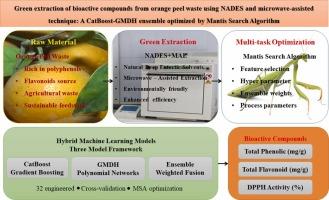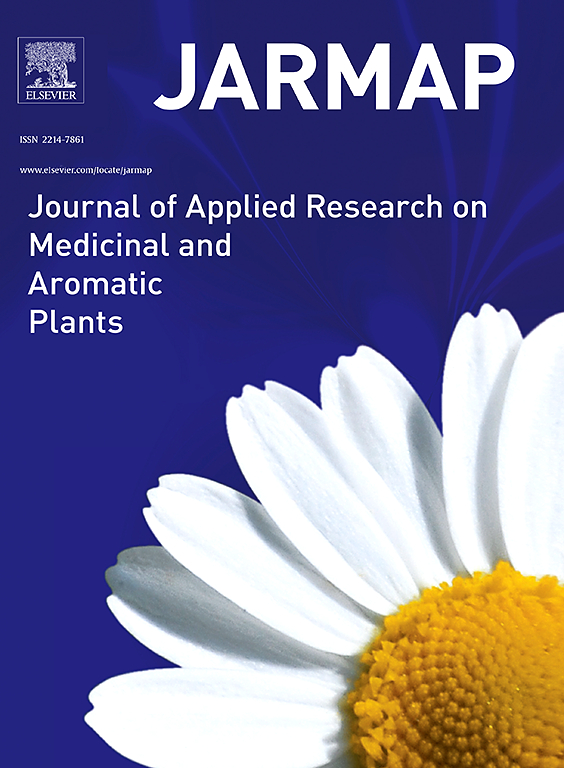Green extraction of bioactive compounds from orange peel waste using NADES and microwave-assisted technique: A CatBoost-GMDH ensemble optimized by mantis search algorithm
IF 3.6
2区 农林科学
Q1 PLANT SCIENCES
Journal of Applied Research on Medicinal and Aromatic Plants
Pub Date : 2025-10-06
DOI:10.1016/j.jarmap.2025.100668
引用次数: 0
Abstract
The increasing need for sustainable and efficient extraction methods has led to interest in green technologies for the extraction of bioactive compounds from agricultural waste. Orange peel, a rich of polyphenols and flavonoids, offers significant potential for sustainable application. This research formulated a novel multi-task optimization approach combining the Mantis Search Algorithm (MSA) with hybrid machine learning models to extract bioactive compounds from orange peel waste using natural deep eutectic solvents (NADES) and microwave-assisted extraction (MAE). The holistic strategy employed a multi-task optimization approach that concurrently optimized four key components: feature selection, model hyperparameters, ensemble weights, and process parameters. The process parameters investigated included microwave power (302–495 W), extraction temperature (31–59 °C), extraction time (5.2–30 min), and mass-to-solvent ratio (41–80 mg/mL). Three machine learning models were developed and systematically compared: CatBoost, Group Method of Data Handling (GMDH), and their weighted ensemble fusion. The ensemble MSA-hybrid model exhibited the best predictive performance with R² of 0.656, 0.981, and 0.990 for total phenolic content, total flavonoid content, and DPPH radical scavenging activity, respectively. Temperature was found to be the most significant process parameter for all response variables, followed by extraction time and mass-to-solvent ratio. The multi-task optimization approach successfully developed robust predictive models capable of guiding extraction parameter selection for improved bioactive compound yields. Extensive validation using thorough residual analysis, stability testing, and confidence interval analysis reaffirmed model reliability and generalizability. This novel study was successful in offering valuable industry-ready solutions for sustainable bioactive compound extraction while supporting agricultural waste valorization and circular economy concepts.

利用NADES和微波辅助技术绿色提取桔皮废弃物中的生物活性化合物:一个由螳螂搜索算法优化的CatBoost-GMDH集合
对可持续和高效的提取方法的需求日益增加,导致人们对从农业废物中提取生物活性化合物的绿色技术产生了兴趣。橘皮富含多酚类和类黄酮,具有重要的可持续应用潜力。本研究提出了一种新的多任务优化方法,将螳螂搜索算法(MSA)与混合机器学习模型相结合,利用天然深共晶溶剂(NADES)和微波辅助萃取(MAE)从橙皮废弃物中提取生物活性化合物。整体策略采用多任务优化方法,同时优化四个关键组件:特征选择、模型超参数、集成权重和过程参数。研究的工艺参数包括微波功率(302 ~ 495 W)、提取温度(31 ~ 59℃)、提取时间(5.2 ~ 30 min)、料液比(41 ~ 80 mg/mL)。开发并系统地比较了三种机器学习模型:CatBoost、数据处理组方法(GMDH)及其加权集成融合。综合msa -杂交模型预测总酚含量、总黄酮含量和DPPH自由基清除能力的R²分别为0.656、0.981和0.990,预测效果最好。温度是影响反应的最重要的工艺参数,其次是萃取时间和质液比。多任务优化方法成功地建立了稳健的预测模型,能够指导提取参数的选择,以提高生物活性化合物的产量。广泛的验证使用彻底的残差分析,稳定性测试和置信区间分析重申了模型的可靠性和概括性。这项新研究成功地为可持续的生物活性化合物提取提供了有价值的工业解决方案,同时支持了农业废物的价值化和循环经济概念。
本文章由计算机程序翻译,如有差异,请以英文原文为准。
求助全文
约1分钟内获得全文
求助全文
来源期刊

Journal of Applied Research on Medicinal and Aromatic Plants
Pharmacology, Toxicology and Pharmaceutics-Drug Discovery
CiteScore
6.40
自引率
7.70%
发文量
80
审稿时长
41 days
期刊介绍:
JARMAP is a peer reviewed and multidisciplinary communication platform, covering all aspects of the raw material supply chain of medicinal and aromatic plants. JARMAP aims to improve production of tailor made commodities by addressing the various requirements of manufacturers of herbal medicines, herbal teas, seasoning herbs, food and feed supplements and cosmetics. JARMAP covers research on genetic resources, breeding, wild-collection, domestication, propagation, cultivation, phytopathology and plant protection, mechanization, conservation, processing, quality assurance, analytics and economics. JARMAP publishes reviews, original research articles and short communications related to research.
 求助内容:
求助内容: 应助结果提醒方式:
应助结果提醒方式:


